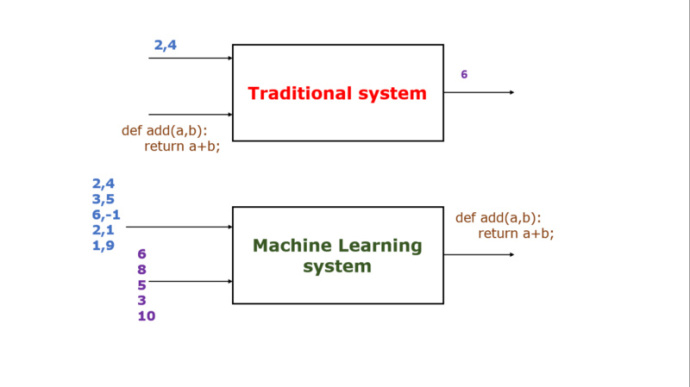Python笔记 #19# 实现bpnn
代码编辑&解释工具:Jupyter Notebook 快速入门
形象说明BP神经网络的用法(图片来自推特):

Bpnn类最主要的三个方法:
- initialize方法,用于设定神经网络的层数、各层节点数
- predict方法,方便用户应用模型做预测
- train方法,用来训练模型
所有代码如下(需要导入numpy模块):
import numpy as np
import math def linear_transformation(matrix, vector):
return vector.dot(matrix) # vector = np.array([1, 2])
# matrix = [[1, 2], [3, 4]]
# vector = linear_transformation(matrix, vector)
# print("linear_transformation:", vector)
# print("linear_transformation:", type(vector)) def active(vector, f):
return np.array(list(map(lambda x: f(x), vector))) def sigmoid(x): # 激活函数
return 1.0 / (1.0 + math.exp(-x)) # result = active(vector, sigmoid)
# print("active:", result)
# print("active:", type(result)) class Bpnn:
# model是一个list,例如[2, 2, 3, 1]表示输入结点2个,第一个隐含层有2个节点,第二个隐含层有3个节点,输出结点1个
def initialize(self, model):
# 随机生成模型对应的矩阵(网络权重)和偏置
self.matrixs = []
self.biases = []
for i in range(len(model) - 1): # 矩阵个数为总层数减1,例如4层的网络只需要3个矩阵就可以了
self.matrixs.append(np.random.randn(model[i], model[i + 1])) # 矩阵的列数是对应输入节点的个数,矩阵的行数对应输出节点的个数 for i in range(len(model) - 1):
# 列表中的每个np数组代表一整层节点的偏置
self.biases.append(np.random.randn(model[i + 1])) def predict(self, vector):
result = np.array(vector)
for i in range(len(self.matrixs)): # 其实就是对一个向量做多次线性变换
result = linear_transformation(self.matrixs[i], result) + self.biases[i]
result = active(result, sigmoid)
return result def neural_net_output(self, feature): # 记录各层的输出
result = []
output = active(linear_transformation(self.matrixs[0], np.array(feature)) + self.biases[0], sigmoid)
result.append(output)
for i in range(len(self.matrixs) - 1):
output = active(linear_transformation(self.matrixs[i + 1], output) + self.biases[i + 1], sigmoid)
result.append(output)
return result # 格式为[[代表第1层输出的向量], [代表第2层输出的向量], ...,[代表最终输出的向量]],所有向量都是一维的np.array,向量长度为该层节点数 def compute_error(self, prediction, actual): # 计算各层的误差,actual是样本标记值(期望获得的值)
result = []
prediction = prediction[:] # 后面的处理都不影响原始数组
prediction.reverse() # 转置便于处理
error = prediction[0] * (1 - prediction[0]) * (actual - prediction[0]) # 计算最终输出的误差
result.append(error)
for i in range(len(self.matrixs) - 1): # 计算每层的误差,可以通过转置矩阵计算上一层误差的一个因子
error = prediction[i + 1] * (1- prediction[i + 1]) * linear_transformation(self.matrixs[-1 - i].T, error)
result.append(error)
result.reverse()
return result # 格式为[[代表第1层输出误差的向量], [代表第2层输出误差的向量], ...,[代表最终输出误差的向量]],所有向量都是一维的np.array,向量长度为该层节点数数 def update_network(self, feature, prediction, error, LEARING_RATE):
# 更新权重(手算凑出来的计算方法↓)
temp = np.ones_like(self.matrixs[0])
temp = temp * LEARING_RATE * error[0]
temp = temp.T * np.array(feature)
temp = temp.T
self.matrixs[0] += temp;
for i in range(len(self.matrixs) - 1):
temp = np.ones_like(self.matrixs[i + 1])
temp = temp * LEARING_RATE * error[i + 1]
temp = temp.T * prediction[i]
temp = temp.T
self.matrixs[i + 1] += temp; # 更新偏置
for i in range(len(self.biases)):
self.biases[i] += LEARING_RATE * error[i] def train(self, get_batch, MAX_ITERATION, LEARING_RATE, MAX_LOSS):
loss = MAX_LOSS = abs(MAX_LOSS)
count = MAX_ITERATION
while abs(loss) >= MAX_LOSS and count > 0:
batch = get_batch()
for example in batch:
prediction = self.neural_net_output(example.feature)
error = self.compute_error(prediction, example.label)
self.update_network(example.feature, prediction, error, LEARING_RATE)
loss = abs(np.mean(error[-1])) # 取最后一次迭代最终输出的平均值作为本批次的误差
count = count - 1
print("迭代次数:", MAX_ITERATION - count)
print("误差:", loss) class LabeledExample:
def __init__(self, feature, label):
self.feature = feature
self.label = label # 训练一个类似于异或(xor)运算的函数,相同为假,相异为真
labeled_examples = [LabeledExample([0, 0], [0]), LabeledExample([0, 1], [1]), LabeledExample([1, 0], [1]), LabeledExample([1, 1], [0])] def full_batch():
return labeled_examples bpnn = Bpnn()
bpnn.initialize([2, 2, 1]) # 构造一个三层的神经网络,输入节点2个,隐含层节点2个,输出节点1个
bpnn.train(full_batch, 10000, 0.6, 0.01) # 学习因子为0.6, 最大允许误差0.01
print("输入层与隐含层权值", bpnn.matrixs[0])
print("隐含层权值与输出层权值", bpnn.matrixs[1])
print("隐含层阈值", bpnn.biases[0])
print("输出层阈值", bpnn.biases[1])
sample1 = [0.05, 0.1]
sample2 = [0.2, 0.9]
sample3 = [0.86, 0.95]
print("预测样本", sample1, "的结果是:", bpnn.predict(sample1))
print("预测样本", sample2, "的结果是:", bpnn.predict(sample2))
print("预测样本", sample3, "的结果是:", bpnn.predict(sample3))
Python笔记 #19# 实现bpnn的更多相关文章
- python笔记-19 javascript补充、web框架、django基础
一.JavaScript的补充 1 正则表达式 1.1 test的使用 test 测试是否符合条件 返回true or false 1.2 exec的使用 exec 从字符串中截取匹配的字符 1.3 ...
- python笔记19
今日内容 面向对象基本用法 好处和应用场景 面向对象的三大特性 内容详细 1.面向对象基本格式 # ###### 定义类 ###### class 类名: def 方法名(self,name): pr ...
- python笔记 - day6
python笔记 - day6 参考: http://www.cnblogs.com/wupeiqi/articles/5501365.html 大纲: 利用递归,实现阶乘: Python反射 pyt ...
- python笔记 - day5
python笔记 - day5 参考: http://www.cnblogs.com/wupeiqi/articles/5484747.html http://www.cnblogs.com/alex ...
- s21day21 python笔记
s21day21 python笔记 一.内容回顾及补充 内置函数补充 type():查看数据类型 class Foo: pass obj = Foo() if type(obj) == Foo: pr ...
- s21day19 python笔记
s21day19 python笔记 一.面向对象的基本知识 1.1 基本格式 # 定义类 class 类名: def 方法名(self,name): print(name) return 123 de ...
- s21day05 python笔记
s21day05 python笔记 一.昨日内容回顾及补充 回顾 补充 列表独有功能 extend:循环添加到一个列表中 1.users = ['张三',66],people = ['王五',99] ...
- python笔记-1(import导入、time/datetime/random/os/sys模块)
python笔记-6(import导入.time/datetime/random/os/sys模块) 一.了解模块导入的基本知识 此部分此处不展开细说import导入,仅写几个点目前的认知即可.其 ...
- python笔记(2)--字符串
一.字符串 字符串是不可变序列,具有序列的公共操作方法,具体操作见python笔记(1)--序列(列表 元组 range) 1.创建字符串 单引号:'Hello , I am Logan ! ' 双引 ...
随机推荐
- IOP知识点(3)-Modal.show
1.position 模态框初始位置.可设为字符串 "左位置 上位置" 或数组 [左位置, 上位置],规则如下: 左位置 可设为 left|center|right 三者之一,上位 ...
- Request实例
Request常用方法 getRequestURL方法返回客户端发出请求时的完整URL. getRequestURI方法返回请求行中的资源名部分. getQueryString 方法返回 ...
- Python itsdangerous 生成token和验证token
代码如下 class AuthToken(object): # 用于处理token信息流程: # 1.更加给定的用户信息生成token # 2.保存生成的token,以便于后面验证 # 3.对用户请求 ...
- 【Java】-NO.20.Exam.1.Java.1.001- 【1z0-807】- OCEA
1.0.0 Summary Tittle:[Java]-NO.20.Exam.1.Java.1.001-[1z0-807] Style:EBook Series:Java Since:2017-10- ...
- js贪心算法---钱币找零问题
function MinCoinChange(coins){ var coins = coins.sort(function(a,b){ return b - a; }); this.makeChan ...
- sqli-labs(一)
第一关:第一关会讲的比较详细,后面的关卡中只有特殊的地方我会单独拿出来说. 第一关是一个很简单的string类型的sql注入,并且会报错,输入参数id=',页面会报错 值得注意的是: 1.报错信息中 ...
- Windows 2012 IIS ASP.NET 安装
from:http://blog.darkthread.net/post-2013-11-29-iis8-asp-net-setup.aspx 專案動用了SignalR 2.0,在我的Windows ...
- rpm方式安装MySQL5.1.73
1.安装MySQL server 首先下载好mysql的rpm安装包 使用rpm命令安装: rpm -ivh MySQL-server-5.1.73-1.glibc23.i386.rpm 命令解释:i ...
- QT5中QByteArray转QString中文乱码
1.添加头文件 #include <QTextCodec> 2.用QTextCodec 设置格式转换 QByteArray barr; barr.insert(0,(char*)(pMsg ...
- anconda1.8+cuda9.0+cudnn7.0.5+tensorflow1.7(win10)安装
1.下载安装cuda9.0 https://developer.nvidia.com/cuda-90-download-archive 2.下载cudnn7.0.5,下载cuda9.0的对应版本 ht ...
